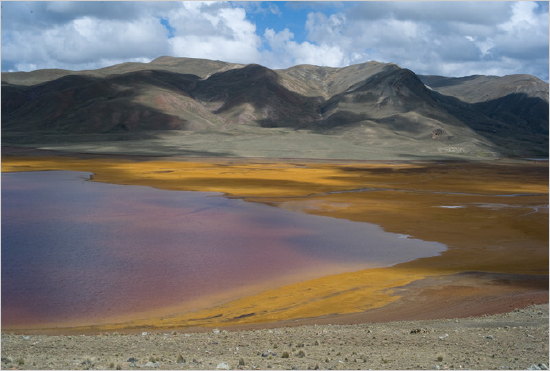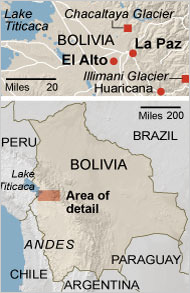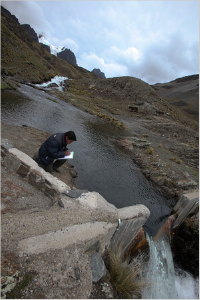
(above) The Milluni reservoir has receded as glaciers that provide some of Bolivia's water and electricity have melted and disappeared. Photo: Ángel Franco/The New York Times
In Bolivia, Water and Ice Tell of Climate Change
December 13, 2009 - New York Times
By ELISABETH ROSENTHAL
EL ALTO, Bolivia -- When the tap across from her mud-walled home dried up in September, Celia Cruz stopped making soups and scaled back washing for her family of five. She began daily pilgrimages to better-off neighborhoods, hoping to find water there.
(below) Edson Ramírez measuring water flow from a glacier. Photo: The New York Times

Though she has lived here for a decade and her husband, a construction worker, makes a decent wage, money cannot buy water.
"I'm thinking of moving back to the countryside; what else can I do?" said Ms. Cruz, 33, wearing traditional braids and a long tiered skirt as she surveyed a courtyard dotted with piglets, bags of potatoes and an ancient red Datsun. "Two years ago this was never a problem. But if there's not water, you can't live."
 (Map right) Glaciers' retreat changed the vistas around La Paz-El Alto. Photo: Ángel Franco/The New York Times
(Map right) Glaciers' retreat changed the vistas around La Paz-El Alto. Photo: Ángel Franco/The New York Times
The glaciers that have long provided water and electricity to this part of Bolivia are melting and disappearing, victims of global warming, most scientists say.
If the water problems are not solved, El Alto, a poor sister city of La Paz, could perhaps be the first large urban casualty of climate change. A World Bank report concluded last year that climate change would eliminate many glaciers in the Andes within 20 years, threatening the existence of nearly 100 million people.
For the nearly 200 nations trying to hammer out an international climate accord in Copenhagen, the question of how to address the needs of dozens of countries like Bolivia is a central focus of the negotiations and a major obstacle to a treaty.
World leaders have long agreed that rich nations must provide money and technology to help developing nations adapt to problems that, to a large extent, have been created by smokestacks and tailpipes far away. But the specifics of that transfer -- which countries will pay, how much and for what kinds of projects -- remain contentious.
Last week, a group of the poorest small countries debated whether they would stage a walk-out in Copenhagen if rich nations failed to provide enough money. Todd Stern, the lead negotiator for the United States, while reiterating that the United States would help pay, bridled at the idea that the money was a "climate debt." And on Friday, the European Union made an initial pledge to pay $3.5 billion annually for three years to help poor countries cope -- though economists project the total cost to be $100 billion or more.
An Angry Voice
With its recent climate-induced catastrophes, Bolivia has become an angry voice for poor nations, demanding that any financing be paid out in full and rapidly.
 (left) Mario Ariquipa Laso, with his wife, Margarita Limachi Álvarez. He is a farmer in Khapi, two hours from La Paz. Photo: Ángel Franco/The New York Times
(left) Mario Ariquipa Laso, with his wife, Margarita Limachi Álvarez. He is a farmer in Khapi, two hours from La Paz. Photo: Ángel Franco/The New York Times
"We have a big problem and even money won't completely solve it," said Pablo Solón, Bolivia's ambassador to the United Nations. "What do you do when your glacier disappears or your island is under water?"
Scientists say that money and engineering could solve La Paz-El Alto's water problems, with projects including a well-designed reservoir. The glaciers that ring the cities have essentially provided natural low-maintenance storage, collecting water in the short rainy season and releasing it for water and electricity in the long dry one. With warmer temperatures and changing rainfall, they no longer do so.
"The effects are appearing much more rapidly than we can respond to them, and a reservoir takes five to seven years to build. I'm not sure we have that long," said Edson Ramírez, a Bolivian glaciologist who has documented and projected the glaciers' retreat for two decades.
The retreat has outpaced his wildest predictions. He had predicted that one glacier, Chacaltaya, would last until 2020. It disappeared this year. In 2006, he said El Alto water demand would outstrip supply by 2009. It happened.
But global warming alone cannot be blamed for the longstanding woes of this exotic but desperately poor landlocked country, where per capita income is around $1,000. Urban water supplies are also taxed by population growth as well as checkered management, in part because there is little money to manage anything, but also because the government nationalized the water company a few years ago, having declared water a human right. El Alto still does not employ a full-time water technician.
Populations at the Brink
"These are populations at the brink of surviving anyway, and then you have the extra stress of climate change and you have huge social problems," said Dirk Hoffmann, head of the climate change program at the Universidad Mayor de San Andrés in La Paz. "What's at stake is conflict -- you wouldn't talk about civil war exactly. But it will be unrest."
In fact, when taps dried up in Celia Cruz's neighborhood, the Solidarity District of El Alto, rich La Paz residents still had water. In a nation that has rallied behind socialist rhetoric and indigenous rights, there were complaints. "The sense of injustice is palpable," said Edwin Chuquimia Vélez, an official in El Alto formerly in charge of water.
Victor Hugo Rico, director of the state water company, Epsas, while acknowledging worries about supply, denied that there had been intentional rationing and said that three wells were being drilled to increase water to El Alto and that more were planned.
Glaciers are part of the majestic landscape here, visible from almost everywhere in the neighboring cities of La Paz and El Alto, each with one million people. Their disappearance from certain vistas is as startling to Bolivians as the absence of the twin towers is to New Yorkers.
"To see this change fills me with sadness. It fills me with pain," said Gonzalo Jaimes, a climbing guide from La Paz.
Chacaltaya, at 17,500 feet, was the world's highest ski area from 1939 until 2005, when the glacier retreated beyond the slopes. The lodge, still stocked with rental gear and decorated with ski murals, sits mostly abandoned.
Though all glaciers expand and retreat over time, recent research has found that small, relatively low-altitude glaciers, like those in Bolivia, are particularly vulnerable to warming temperatures, a phenomenon that glaciologists compare to the fate of small ice cubes in water.
For residents, water has been the biggest issue. Though the region's electricity comes from hydroelectric plants, these depend heavily on rainfall and water from the Amazon, so power loss has so far not been a problem.
In Khapi, a village two hours' drive from La Paz, people regard the Illimani glacier as "our God, our great protector," said Mario Ariquipa Laso, 55, a wizened farmer who grows potatoes and corn on sheer slopes in the shadow of the glacier. Ten years ago, it provided a steady, gentle stream during dry months to keep crops watered. Today, with Illimani in retreat, water "just pours" off the glacier, a yellowish mix.
(below) A view from El Alto, Bolivia, looking toward La Paz. Both have had water shortages, in part because of retreating glaciers.

"It's completely useless," snorted Héctor Hugo Chura Chuque, vice mayor of the village, which has no plumbing and only intermittent electricity.
"A lot of us think about not having kids anymore," said Margarita Limachi Álvarez, 46, a blue Andean cap with ear flaps pulled over her head. "Without water or food, how would we survive? Why bring them here to suffer?"Taps Run Dry
A hundred miles away, in a middle-class neighborhood of El Alto, water has also become a gnawing concern. From September through November, the taps gave forth at best eight hours a day, often with little pressure.
"Sometimes you didn't have it in the morning. Sometimes you didn't have it in the evening -- you never knew," said Julia Torrez, 31 and eight months pregnant, in a neat sitting room furnished with plaid couches and hung with oil paintings. When the tap started spurting, she recalled, she ran to fill an array of buckets and jugs, an incongruous routine for this family of jeans-wearing, college-educated professionals.
In October, La Paz officials began closing the car washes on Avenida Kollasuyo, relenting only when some rain came in late November. "This was the first time we've been told there was not enough water for us to operate," said Omar Mamaru, 25, owner of Auto-Stop, in thick orange gloves and a windbreaker, as he scrubbed a blue S.U.V.
In the last few years, Bolivian lives have also been buffeted by an almost biblical array of extreme weather events, many of which scientists believe are probably linked to climate change. -- though this is currently difficult to prove because poor countries like Bolivia have little long-term scientific data. This year brought scorching temperatures and intense sun. A drought killed 7,000 farm animals and sickened nearly 100,000.Severe storms normally associated with El Niño periods, every seventh year, now occur regularly. Warmer temperatures mean new crop pests -- crickets and worms -- as well as diseases like malaria and dengue fever.
On a recent morning in Huaricana, a village an hour from La Paz, people used rocks and timber to repair a road bisected by a 40-foot-wide river of mud delivered by a potent storm. A vendor sold ice cream to children watching the now familiar scene. "This has only been happening the last three years," said Oswaldo Vargas, 55, as he towed a public bus across the mud with his Fiat tractor.
Developed countries agree that they have an obligation to help relieve such stresses, but many remain hesitant to release funds, in part because poor countries have few concrete plans to address climate problems. The effects of climate changes have not yet been analyzed or quantified by Epsas, the water company, for example.But with little cash or expertise, it is hard to plan a giant new reservoir or a system to transfer water from one part of the country to another. Bolivia's poor, said Edwin Torrez Soria, an engineer with Aqua Sustentable, who works with villages near the Illimani glacier, "aren't responsible for what's happening to the glacier but they suffer the most, and unfortunately the government doesn't have much of a plan."
This year, the last days of November provided a bit of wet relief -- the rainy season had started, about a month later than usual. The pipe outside Ms. Cruz's house started running.
But the rain that had added ice to the glaciers now often just increases their runoff, because it is too warm to freeze anymore.
"Right now we're living on additional glacier melt that won't be here in a few years," said Mr. Hoffmann, of the climate change program. "Isn't that ironic?"
Jean Friedman-Rudovsky contributed reporting from El Alto, Bolivia.